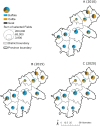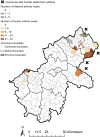Informing One Health Anthrax Surveillance and Vaccination Strategy from Spatial Analysis of Anthrax in Humans and Livestock in Ha Giang Province, Vietnam (1999-2020)
- PMID: 36689942
- PMCID: PMC9978550
- DOI: 10.4269/ajtmh.22-0384
Informing One Health Anthrax Surveillance and Vaccination Strategy from Spatial Analysis of Anthrax in Humans and Livestock in Ha Giang Province, Vietnam (1999-2020)
Abstract
Anthrax, caused by Bacillus anthracis, has a nearly global distribution but is understudied in Southeast Asia, including Vietnam. Here, we used historical data from 1999 to 2020 in Ha Giang, a province in northern Vietnam. The objectives were to describe the spatiotemporal patterns and epidemiology of human and livestock anthrax in the province and compare livestock vaccine coverage with human and livestock anthrax incidence. Annual incidence rates (per 10,000) for humans, buffalo/cattle, and goats were used to explore anthrax patterns and for comparison with livestock annual vaccine variations. A data subset describes anthrax epidemiology in humans by gender, age, source of infection, type of anthrax, admission site, and season. Zonal statistics and SaTScan were used to identify spatial and space-time clusters of human anthrax. SaTScan revealed space-time clusters in 1999, 2004, and 2007-2008 in the province, including in the northeastern, eastern, and western areas. Most human anthrax was reported between July and October. Most patients were male, aged 15-59 years, who had handled sick animals and/or consumed contaminated meat. High case-fatality rates were reported with gastrointestinal or respiratory cases. Our data suggest that vaccination in buffalo and cattle reduces the disease burden in humans and vaccinated animals but does not reduce the incidence in unvaccinated animals (goats). This study identified spatial areas of high risk for anthrax and can inform One Health surveillance and livestock vaccination planning in contextual settings similar to Ha Giang province.
Figures








Similar articles
-
Spatial analysis of human and livestock anthrax in Dien Bien province, Vietnam (2010-2019) and the significance of anthrax vaccination in livestock.PLoS Negl Trop Dis. 2022 Dec 20;16(12):e0010942. doi: 10.1371/journal.pntd.0010942. eCollection 2022 Dec. PLoS Negl Trop Dis. 2022. PMID: 36538536 Free PMC article.
-
Spatial analysis of human and livestock anthrax in Lai Chau province, Vietnam (2004-2021).Acta Trop. 2024 Jan;249:107044. doi: 10.1016/j.actatropica.2023.107044. Epub 2023 Oct 20. Acta Trop. 2024. PMID: 37866728
-
Incidence and Spatial distribution of Human and Livestock Anthrax in Cao Bang Province, Vietnam (2004-2020).Vector Borne Zoonotic Dis. 2023 May;23(5):306-309. doi: 10.1089/vbz.2022.0072. Epub 2023 May 3. Vector Borne Zoonotic Dis. 2023. PMID: 37140464 Free PMC article.
-
Ecology and epidemiology of anthrax in cattle and humans in Zambia.Jpn J Vet Res. 2006 May;54(1):15-23. Jpn J Vet Res. 2006. PMID: 16786974 Review.
-
Anthrax outbreaks in the humans - livestock and wildlife interface areas of Northern Tanzania: a retrospective record review 2006-2016.BMC Public Health. 2018 Jan 5;18(1):106. doi: 10.1186/s12889-017-5007-z. BMC Public Health. 2018. PMID: 29304765 Free PMC article. Review.
Cited by
-
Anthrax in Humans, Animals, and the Environment and the One Health Strategies for Anthrax Control.Pathogens. 2024 Sep 7;13(9):773. doi: 10.3390/pathogens13090773. Pathogens. 2024. PMID: 39338965 Free PMC article. Review.
References
-
- Carlson CJ et al. 2019. The global distribution of Bacillus anthracis and associated anthrax risk to humans, livestock and wildlife. Nat Microbiol 4: 1337–1343. - PubMed
-
- World Health Organization, Food and Agriculture Organization of the United Nations and World Organization for Animal Health , 2008. Anthrax in Humans and Animals. 4th ed. Geneva, Switzerland: World Health Organization.
Publication types
MeSH terms
LinkOut - more resources
Full Text Sources
Medical

